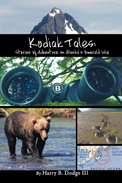
 |
The stories contained within Dodge’s collection are all set in and inspired by the Kodiak Archipelago, which the author aims to depict “with respect and appreciation for Kodiak’s beauty, abundant natural resources, and rich cultural past.” And that is what the reader gets from Dodge’s varied stories and factual accounts. They all speak to the “unique ecosystem” of the Kodiak Archipelago, a land “isolated from mainland Alaska for at least 200,000 years.” It is a region where secrets are revealed, where man and nature converge in unpredictable ways, and where isolation is understood and sometimes feared.
Part One includes eight original short stories, in which Dodge proves himself a worthy writer of fiction, while Part Two comprises the author’s “personal accounts of adventures in Kodiak’s backcountry.” The stories and accounts, some previously published elsewhere, all demonstrate the author’s deep affection and admiration for this terrain, history, wildlife, and peoples. A few stories stand out among the rest that give evidence to Dodge’s ability to give us an unrestrained, gritty, and evocative view of this wild and out-of-the-way world.
In arguably one of the strongest stories, “Bear Country,” a father and son attempt a fresh start and “new beginning in the Last Frontier.” The father/son excursion in the Alaskan wilds is meant to bring the two closer, but it doesn’t necessarily happen in the way either imagines. The son, Dirk, is a typical teenage boy, sullen and withdrawn into his own private world. The father, referred to as Mr. Rivers, desperately seeks the son he is losing and with whom anything can open “the flood-gates of animosity.” Though Mr. Rivers brings his son out for his first official deer hunt, it’s the thrill of seeing a bear that excites Dirk more. The existing tension between them is tested, which leads to surprising truths of deep-rooted propensities for violence. “Flies buzzed around a salmon carcass. The skin was peeled back from the skeleton, and bits of meat, red as blood, clung to the bones.” This is only a taste of what Dodge presents with the rugged environment in which Mr. Rivers watches his son transform. “Gone was the sullen pout, the look of total disdain, and the demeanor of eager defiance that had grown over him like a shell, making him a stranger to his own father.” The hunt seems to do the trick of reconnecting father to son, but the magic soon disappears when they return to familiar habits. It isn’t until a raw encounter with nature that they finally find a new beginning and venture together into unfamiliar territory.
“The Trapper” is a haunting tale that wanders into dreamy surrealism. A man named Tony deals with the disturbance of an “unwanted guest,” a vole that Tony has difficulty trapping. He lives remotely in a cabin in the midst of winter, where Dodge gives a true example of isolation and chilling imagery of “the guttering light of the kerosene lantern” and the “chill fingers” of winter’s stillness. When Tony goes out to check other traps for otters and foxes, frustration sets in with the lack of trapping anything, an urgent reminder of his own survival. A mysterious visitor appears at Tony’s cabin one night, a stranger that sends “a cold fear” over Tony. As he nervously attempts hospitality, Tony remains wary of possible danger and sleeps with his .22 close. Things turn strange and dark after a shivery moment when Tony wakes from a disturbing dream to see something “slowly rise from the floor” and finds the stranger looming over him, having “crawled stealthily across the floor, holding to the darkness.” What happens after sends Tony into an altered reality where his safety is illusory, and he is unsure of what is real and what is not.
In “Across Kodiak,” one of Dodge’s personal adventures, he recounts the experience of trekking “raw and bloodied” with a friend across the wild tundra of Kodiak Island. Here, Dodge and his friend encounter bears while exploring the diverse landscape of cottonwood trees, black birch, spruce among the cold waters and rivers, granite boulders, and wildlife, along with unpredictable weather. They track the successes and failures and miles of their journey completed each day while fighting the nuisance of white sox, “Kodiak’s pesky little flies.” As they travel, the sometimes harsh and unforeseeable conditions are constant reminders of their vulnerability against the powers of nature. Their journey changes the closer they get to civilization—encountering more people and edging closer to their finish line: the “Welcome to Kodiak” sign. From this experience and achievement is a lifelong memory that remains with the author to this day of what they “endured in order to span the length of magnificent and wondrous Kodiak Island.” One will share in Dodge’s experiences and stories and marvel at the beauty and majesty of a place “where countless stories, dramas and traditions lie hidden.”